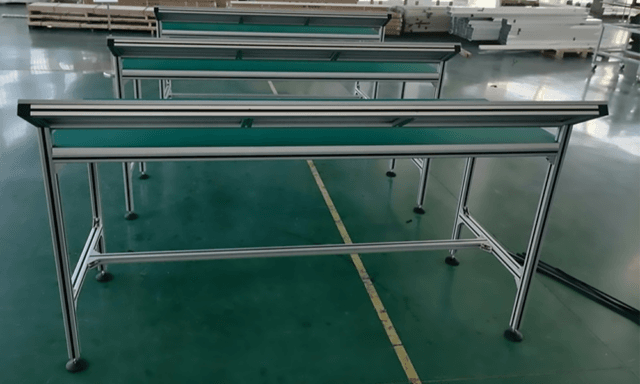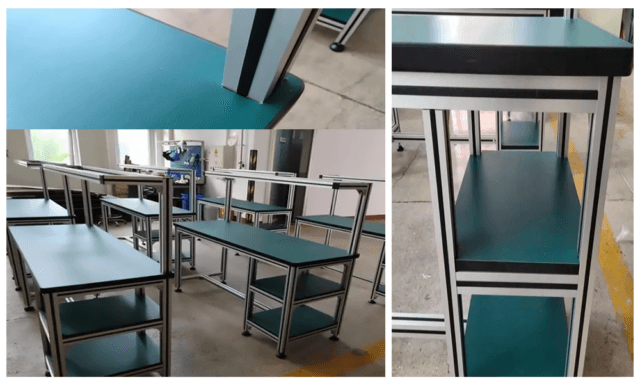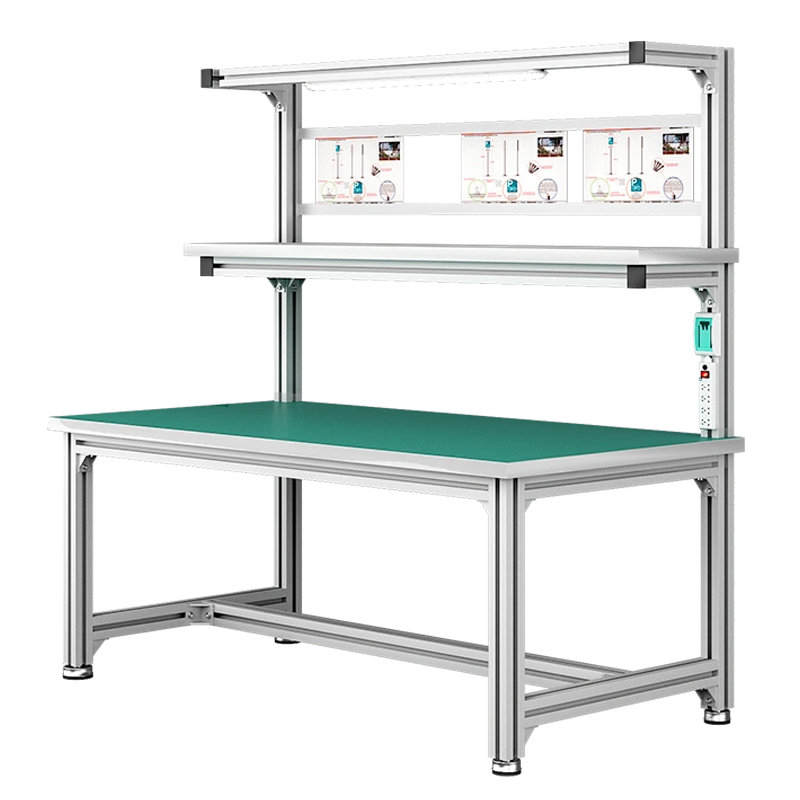Aluminum Workbench: a modular, durable solution tailored for efficiency across various industries. Constructed with a robust aluminum frame, this workbench offers an ergonomic design for comfortable use and enhanced productivity. With customization options, it can include anti-static surfaces, upper shelves, lighting, and more.
Description
Hot Sale Aluminum Extrusion Workbench
Aluminum profile workbench, we also call it aluminum alloy profile workbench, aluminum profile operating table, anti-static workbench, anti-static workstation, etc. Besides, aluminum profile workbench can be equipped with various production tools. Such as lamps, hanging boards, electrical processing tools, etc. according to different work needs of users.
Besides, workstations with aluminum profiles are categorized by their specific applications:
1. Anti-static Workbench: Constructed with anti-static materials, a dense particleboard, and framed with aluminum profiles, so we typically employ this workbench in the food and manufacturing sectors.
2. Laboratory Workbench: People design this aluminum-framed workstation for laboratory use and dedicate to research and experimentation.
3. Multifunctional Workbench: Features additional functionalities, such as integrated exhaust and conveyor systems for complex tasks.
4. Electrical Workbench: A specialized workbench geared towards tasks within the electrical industry.
5. Inspection Workbench: Utilized for assessing the quality of products, this workbench relies on an aluminum profile structure for stability.
The adoption of industrial aluminum profiles across various sectors is growing due to the ease of assembly and disassembly these profiles offer. Besides, they eliminate the need for welding, allowing for quick construction with corresponding fittings.

aluminum workbenches customized size
Application of Aluminum Profile Workbench in Precision Measurement Field
Aluminum profile workstations find extensive use in precision measurement fields, characterized by:
Laboratory Workbenches:
Contextual Application: Primarily used for precision measurements and tests, providing an ideal surface for delicate instruments.
Design: While they may not support heavy loads, we ergonomically design these workbenches for user comfort and efficiency.
Accessories: Commonly outfitted with versatile components including monitor stands and instrument tables, and feature anti-static treatments.
As a Reference Surface:
Functionality: Well-suited for inspection roles, especially serving as a stable reference for precision measurements.
Usage: They facilitate the inspection of machinery, verify part dimension accuracy, and assist with detailed markings.
Load-Bearing and Stability:
Standard Workbenches: Can typically bear loads exceeding 500 kg, with the aluminum frame ensuring both steadiness and strength.
Laboratory Workbenches: Though not designed for heavy loads, their design satisfactorily supports precise instrument placement and testing.
Durability and Environment Suitability:
Material Benefits: Aluminum profile workbenches are lightweight yet robust, with a surface that resists dust and oil adherence, simplifying maintenance.
Environmental Resistance: These workbenches can withstand various environments. Though humidity may pose a risk; regular upkeep can prolong their function.
Industry-Specific Applications:
Environmental Monitoring: Instrument stabilization for environmental assessments, such as gas analyzers or particle meters.
Academic Research: Research settings utilize these workbenches for high-precision measurements and experimental tasks.
Healthcare Industry: Supporting the healthcare sector, so they hold and stabilize medical precision instruments vital for diagnostics and treatments.
In summation, the significance of aluminum profile workbenches in precision measurement is substantial, given their thoughtful structural design, reliable support, and wide-ranging environmental resilience and accessory configurations.
Features:
The aluminum profile workbench has the following characteristics:
1. Lightweight and flexible: The workbench made of aluminum profile is light in weight and easy to carry and install. At the same time, we can cut the aluminum profile and splice as needed, with high flexibility.
2. Strong corrosion resistance: Aluminum itself has good corrosion resistance. So it can adapt to humid and corrosive environments and is not easy to rust.
3. Stable structure: The aluminum profile workbench has a stable structure and strong support capacity, and can withstand heavier tool and equipment loads.
4. Easy to operate: The surface of the aluminum profile workbench is flat
5. Multifunctional: We can equip the aluminum profile workbench with various accessories. Meanwhile tool brackets can meet different work needs and improve work efficiency.
How to Choose the Table Top of an Aluminum Profile Workbench?
As one of the important tools in the workshop, we can customize the aluminum profile workbench in different styles according to different usage requirements. So the aluminum workbench will meet the needs of different customers. Therefore, different types of panels and auxiliary tools can achieve different functions. Here are some common types of panels for aluminum profile workbenches:
1. Composite board table material: A high-density composite board composed of 2mm thick polymer materials is used, and adhesives are added to the base material for strong bonding.
Features: It is relatively light in weight, has high strength, acid and alkali corrosion resistance, and high temperature resistance; high heat resistance and strong insulation performance; the table top is surrounded by high-strength plastic edge sealing, which can resist greater impact, is strong and durable, and can be used for light and heavy workbench table tops, suitable for mold factories, auto parts factories, and building materials factories.
2. Anti-static table material: The surface is made of anti-static melamine fireproof board, plus a conductive substrate. The conductive substrate is mostly made of graphite composite board with good conductivity, and a 3mm thick green rubber table mat is placed on it. At the same time, people should connect the anti-static device accessories to guide the static electricity to the ground to play an anti-static role.
Features: beautiful, lightweight, high strength, wear-resistant, corrosion-resistant, anti-static, used for electronic products and workshops with strict requirements on static electricity, suitable for light industries. Such as electronic and electrical factories, clean rooms, textile factories, paper mills, and garment factories.

Other Table Tops
3. Iron plate countertop material: high-density composite board is used, and a layer of 5mm thick iron sheet is laid on it.
Features: It has high strength, strong impact resistance, wear resistance, and strong bearing capacity. People can use it for heavy-duty benches, suitable for mold factories and machinery factories.
4. Wood countertop material: wooden countertops integrated with imported beech and domestic hard miscellaneous wood.
Features: It has a large bearing capacity, can resist large impacts, is relatively wear-resistant, and we use it for the assembly of benches. So it is suitable for paper mills, parts workshops, assembly workshops, logistics industries, ceramics, and glass factories.
5. Stainless steel countertop material: high-density composite board is used, and a layer of 1.5mm thick stainless steel is wrapped on the outside.
Features: It has high strength, acid and alkali corrosion resistance, smooth and beautiful appearance, easy to clean, and will not cause secondary pollution to the product. So we can use it for packaging and testing workbenches of light and heavy workbenches. Besides, it is suitable for use in electronics factories, daily chemical factories, stationery, clean rooms, precision instrument factories, food workshops, and printing factories.





